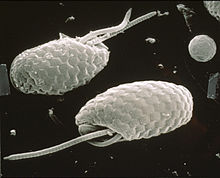Cryptophyta
Cryptophyta, Cryptomonada or cryptophyta is a small group of unicellular algae with about 200 species that live in marine and continental waters. important members of the phytoplankton and can be found in stagnant waters, supporting moderate levels of pollution. They are especially abundant in cold waters such as high mountain lakes and in arctic and antarctic waters. In general, cryptophytes are mixotrophs, that is, capable of both photosynthesis and phagotrophy. They have a rigid cover, a ventral invagination (hence the name crypto, which means hidden) from which two flagella emerge and several rows of ejectosomes, with a defensive function. Some species form zooxanthellae, that is, they live as symbiotic animals.
Ecology
Cryptophytes can be found in all seas, in freshwater and in stagnant water, including interstitial pools on sandy beaches. Approximately half of the species are freshwater and the other half are marine. They are especially abundant in cold waters and seem to be very sensitive to the amount of light they receive, often living in the deepest parts of the northernmost clear oligotrophic lakes and high mountains.
They are capable of surviving during the winter in waters covered with snow or ice, in this case, moving to the most superficial area in order to receive a sufficient amount of light. Survival in these low light conditions requires both a highly efficient photosynthetic system and reduced rates of cellular respiration at low temperatures. When the ice melts and the amount of light increases considerably, the cryptophytes move to the deeper waters to avoid excess light. They are also the dominant species in Antarctic freshwater lakes.
Cryptophytes are mainly mixotrophs, capable of photosynthesis, although some members are fully heterotrophs. Phagotrophic ingestion of bacteria provides them with the source of phosphorus and nitrogen they need under nutrient-poor conditions.
Features

Cryptophytes are unicellular and biflagellate, with cells that are oval and flattened and about 10-50 μm in size. Some occur in coccoid or palmeloid forms (groups of cells surrounded by a mucilage cover) and there is a filamentous genus. For example, Cryptomonas can present a palmelloid state from which it can be easily released to return to a motile form. They can also form cysts, surrounded by a cell wall and in suspended animation, which allow them to survive in unfavorable conditions.
The cell body of cryptophytes is asymmetric, organized dorsiventrally. The cells have a ventral invagination from which two nearly equal anterior flagella emerge. The flagella present fibrils or mastigonemas, which in the shortest are organized in one row, but in the longest they are in two opposite rows. The flagella are inserted asymmetrically on the right side of the invagination, causing rotation around the longitudinal axis when swimming.
Cryptophytes do not have a true cell wall. The specific cover that surrounds the cryptophyte is a periplast with two layers, one internal and one external to the plasmatic membrane. The outer layer is fibrous, while the inner layer has proteinaceous plates. Additionally, they can present small external polygonal plates both on the cell surface and on the flagella.
They have ejectosomes that they use for defense, since they can be shot abroad. They consist of two spiral filaments held under tension. If the cell receives a stimulus, be it mechanical, chemical, or light, the ejectosomes are discharged, propelling the cell away from the disturbance in a zig-zag trajectory. Large ejectosomes, visible under a light microscope, are associated with intussusception; the smaller ones lie below the periplast.
Some cryptophytes have an eyespot, a light-sensitive organelle made up of a single row of granules that may be located within the membrane surrounding the chloroplast or elsewhere in the cell. A contractile vacuole for regulation of osmotic pressure located at the apex of the cell is present in all freshwater species. Mitochondria have flat cristae.
Reproduction is asexual, by simple longitudinal division and mitosis is open. Sessile or colonial species produce zoospores. Sexual reproduction has been recently observed.
For the characteristics of plastids, see class Cryptophyceae.
Classification
Three orders are distinguished into two classes.
- Cryptocurrencies. They present chloroplasts or leucoplasts, the latter present in three lineages that lost photosynthetic capacity. They do not have cytostoma or cytopharynx, although they are able to ingest bacteria apparently using contactyl vacuolas. It includes about twenty-five genera and most species.
- Goniomonadales. They lack all kinds of pests and have a cytostoma that they use for the ingestion of bacteria. Only one gender has been described, Goniomonas.
- Kathablepharida. It is a group of predatory organisms related to the previous ones, which ingest eukaryotic prey through an apical cytostoma with the support of longitudinal microtubule bands. Plasts have not been observed, although some species are cleroplastic, stealing the chloroplasts from the prey they swallow. We know about four genres.
Cavalier-Smith includes them in the proposed kingdom Chromista in the Cryptista group, made up of cryptomonads, goniomonads, katablepharids and other related heterotrophic organisms. However, several specialists suggest that more phylogenetic studies are necessary to define the relationship between Cryptophyta and Chromista.
Contenido relacionado
Natural Sciences
Posidoniaceae
Calathea
